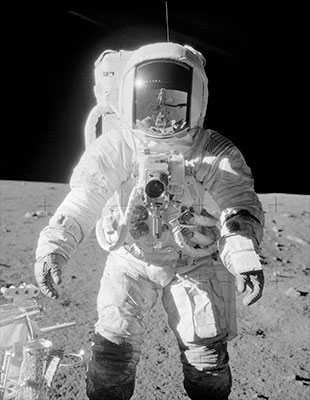Astronauts in space, on Earth mourn loss of Apollo moonwalker Alan Bean As Apollo 12 lunar module pilot, Alan Bean became the fourth man to walk on the moon in November 1969. (NASA)
As Apollo 12 lunar module pilot, Alan Bean became the fourth man to walk on the moon in November 1969. (NASA)May 28, 2018 – The death of Apollo moonwalker and artist Alan Bean elicited tributes by his fellow astronauts, on and off the planet.
Bean, who died on Saturday (May 26) at age 86, was the fourth NASA astronaut to walk on the moon, the second to command the first U.S. space station, and the only artist to document his firsthand experiences visiting another world.
"We honor and remember a fallen colleague and hero who helped advance the human species out into space," wrote Expedition 54 flight engineer Drew Feustel from on board the International Space Station. "Alan Bean inspired us all to be better, to be humble, and to strive to share the story of exploration and give our lives meaning."
"Rest In Peace Alan. Ad Astra," Feustel said on Twitter.
Bean was selected with NASA's third group of astronauts. The 1963 class included Bean's future Apollo 12 crewmate Richard Gordon, who preceded him in death in 2017; Buzz Aldrin, who preceded Bean to the moon on Apollo 11; and Walt Cunningham, who preceded Bean to space as a crew member on Apollo 7.
"Alan and I have been best friends for 55 years, ever since the day we became astronauts," said Cunningham, adding his comments to a statement released by Bean's family.
As the head of the Skylab branch for the Astronaut Office, Cunningham worked with Bean, who flew as commmander of the second crewed flight to the orbital workshop.
"We've never lived more than a couple of miles apart, even after we left NASA. And for years, Alan and I never missed a month where we did not have a cheeseburger together," Cunningham said. "We are accustomed to losing friends in our business, but this is a tough one."
Bean was the last living member of the Apollo 12 crew. In addition to Gordon, he was preceded in death by mission commander Pete Conrad in 1999. There are now only four of the twelve Apollo moonwalkers still alive.
"My first close contact with Alan Bean began in August of 1969 with his last four months of preparation as the lunar module pilot for Apollo 12," said Harrison Schmitt, the first and only geologist to walk on the moon on Apollo 17. "Alan and Pete were extremely engaged in the planning for their exploration of the Surveyor III landing site in the Ocean of Storms [and] this commitment paid off with Alan and Pete's collection of a fantastic suite of lunar samples, a scientific gift that keeps on giving today and in the future."
After returning from the moon and leading the then record-setting 59-day expedition aboard Skylab, Bean left NASA to devote his time to painting what he and his fellow Apollo moonwalkers experienced.
"He'd call me to ask about some detail about the lunar soil, color or equipment he wanted to have represented exactly in a painting," recounted Schmitt. "Other times, he wanted to discuss items in the description that he was writing to go with a painting. His enthusiasm about space and art never waned."
"He was my superhero of spaceflight and art," said Nicole Stott, who followed Bean's example by becoming an artist after spending more than 100 days in space. "Thankful for his mentorship, friendship, and beautiful smile."
Before Bean left NASA, he led the operations and training for the next generation of astronaut candidates. His role in that regard continued beyond his 18 years with the space agency.
"When I was in fourth grade, I wrote a letter to Alan Bean. I was so thrilled when he wrote back! It was a life-changing moment that inspired me to become an astronaut," wrote Andrew Morgan on Twitter. NASA just assigned Morgan to fly to the space station in July 2019.
"America lost another legend," said Bob Hines, a member of NASA's 22nd class of astronaut candidates selected in 2017, in a tweet. "Alan Bean was a great American with an unmatched sense of humor, a desire to share lessons with future generations, and a talented artist to boot!"
"We've all benefitted from his wisdom. He will be missed," wrote Hines.
http://www.collectspace.com/news/news-052818a-alan-bean-remembered-astronauts.html